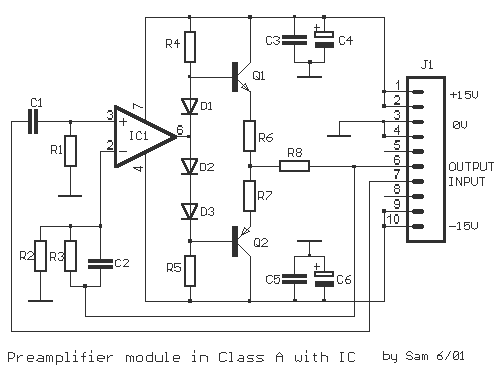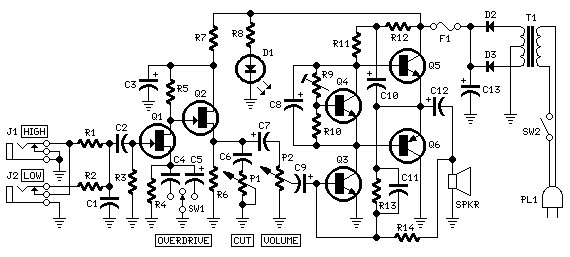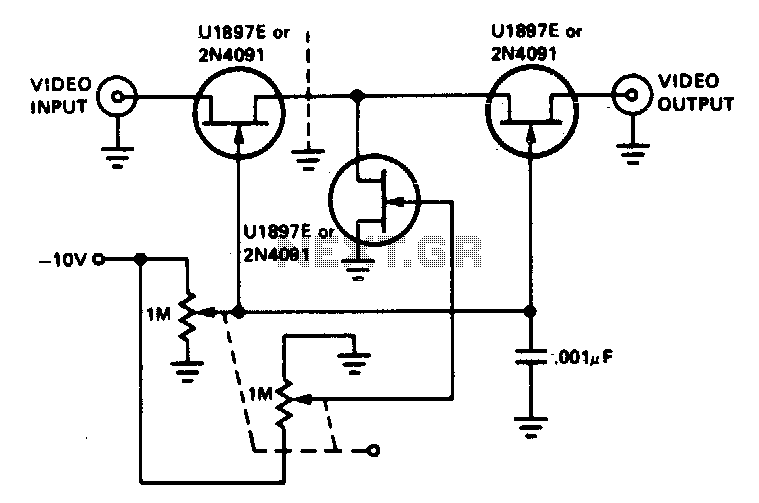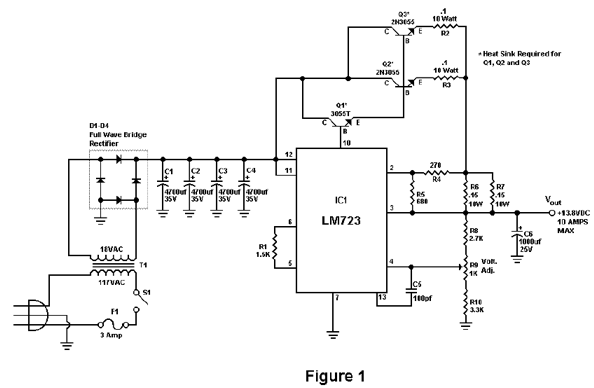
General-Purpose 5W Audio Amplifier With Ac Power Supply
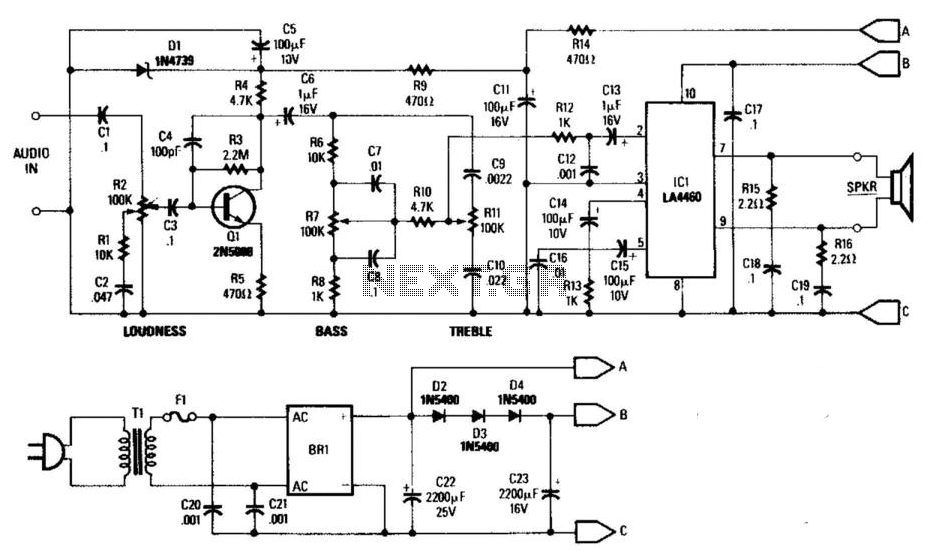
This general-purpose low-power (5 W) audio amplifier is designed to drive speakers ranging from 8 to 12 inches. It utilizes a Sanyo LA4460 integrated circuit (IC) as the audio output component. The circuit features a loudness control, a driver amplifier (Q1), and bass and treble controls that provide approximately ±10 dB boost/cut. This amplifier is versatile and can be applied in various scenarios. It can operate with the specified AC supply or a 12 V DC supply connected to points A & B (positive) and C (negative). For stereo applications, two of these circuits can be utilized with ganged potentiometers at R2, R7, and R11. T1 is a 12 V, 1-amp plug-in transformer. It is important to note that IC1 requires a heatsink for proper thermal management. The power output is approximately 5 W, and a heatsink measuring 4" x 2" x 0.050" is deemed sufficient.
This audio amplifier circuit is designed for low-power applications, making it ideal for small to medium-sized audio systems. The Sanyo LA4460 IC is a dual power amplifier that provides efficient audio amplification with minimal distortion. The inclusion of loudness control allows for enhanced audio performance by adjusting the frequency response to compensate for human hearing sensitivity at lower volumes.
The driver amplifier (Q1) plays a crucial role in driving the output stage of the circuit, ensuring that the audio signal is adequately amplified before reaching the speaker. The bass and treble controls enable users to tailor the audio output to their preferences, enhancing the listening experience by allowing for adjustments in low and high-frequency ranges.
The circuit's power supply options provide flexibility, as it can be powered by either an AC transformer or a DC supply, making it adaptable to various applications. The specified 12 V, 1-amp transformer (T1) is suitable for converting the AC voltage to the necessary DC voltage for the amplifier.
In stereo configurations, the use of ganged potentiometers at R2, R7, and R11 allows for synchronized control of both channels, ensuring a balanced audio output. The requirement for a heatsink for IC1 is critical to prevent overheating during operation, which could lead to performance degradation or damage to the IC. The recommended aluminum heatsink dimensions of 4" x 2" x 0.050" provide adequate thermal dissipation, ensuring the longevity and reliability of the amplifier circuit.
Overall, this low-power audio amplifier circuit is versatile and suitable for a range of applications, from home audio systems to small portable speakers, offering users control over sound quality while maintaining efficient power usage. This general-purpose low-power (5 W) audio amplifier is suitable for driving a spe aker of approximately 8 to 12 inches. A Sanyo LA4460 IC is used as the audio output IC. The circuit consists of a loudness control, driver amplifier Ql, and bass and treble controls of about ±10 dB boost/cut. It should be useful in a wide variety of situations. Either the ac supply shown can be used, or a 12 Vdc supply can be connected to points A&B (positive) and C (negative).
Two of these circuits, using ganged potentiometers at R2, R7, and Rll can be used for stereo applications. T1 is a 12-V 1-amp plug-in transformer. Notice that IC1 must be heatsinked. Power output is about 5 W. A 4" 2" 0.050" aluminum heatsink should be adequate. 🔗 External reference
This audio amplifier circuit is designed for low-power applications, making it ideal for small to medium-sized audio systems. The Sanyo LA4460 IC is a dual power amplifier that provides efficient audio amplification with minimal distortion. The inclusion of loudness control allows for enhanced audio performance by adjusting the frequency response to compensate for human hearing sensitivity at lower volumes.
The driver amplifier (Q1) plays a crucial role in driving the output stage of the circuit, ensuring that the audio signal is adequately amplified before reaching the speaker. The bass and treble controls enable users to tailor the audio output to their preferences, enhancing the listening experience by allowing for adjustments in low and high-frequency ranges.
The circuit's power supply options provide flexibility, as it can be powered by either an AC transformer or a DC supply, making it adaptable to various applications. The specified 12 V, 1-amp transformer (T1) is suitable for converting the AC voltage to the necessary DC voltage for the amplifier.
In stereo configurations, the use of ganged potentiometers at R2, R7, and R11 allows for synchronized control of both channels, ensuring a balanced audio output. The requirement for a heatsink for IC1 is critical to prevent overheating during operation, which could lead to performance degradation or damage to the IC. The recommended aluminum heatsink dimensions of 4" x 2" x 0.050" provide adequate thermal dissipation, ensuring the longevity and reliability of the amplifier circuit.
Overall, this low-power audio amplifier circuit is versatile and suitable for a range of applications, from home audio systems to small portable speakers, offering users control over sound quality while maintaining efficient power usage. This general-purpose low-power (5 W) audio amplifier is suitable for driving a spe aker of approximately 8 to 12 inches. A Sanyo LA4460 IC is used as the audio output IC. The circuit consists of a loudness control, driver amplifier Ql, and bass and treble controls of about ±10 dB boost/cut. It should be useful in a wide variety of situations. Either the ac supply shown can be used, or a 12 Vdc supply can be connected to points A&B (positive) and C (negative).
Two of these circuits, using ganged potentiometers at R2, R7, and Rll can be used for stereo applications. T1 is a 12-V 1-amp plug-in transformer. Notice that IC1 must be heatsinked. Power output is about 5 W. A 4" 2" 0.050" aluminum heatsink should be adequate. 🔗 External reference

